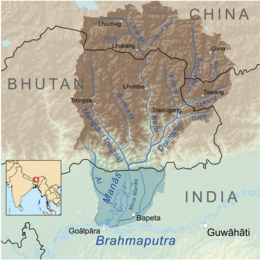
Back মানস নদী Assamese ماناس چایی AZB Манас (рака) Byelorussian Манас (приток на Брахмапутра) Bulgarian মানস নদী, আসাম Bengali/Bangla Manas Catalan Drangme Chhu CEB Mánas (přítok Brahmaputry) Czech Манас (Брахмапутра юппи) CV Manas (Fluss) German
| Manas River | |
|---|---|
 Manas River on the Assam/Bhutan border. | |
 Manas River drainage basin | |
| Location | |
| Country | India, Bhutan, China |
| Physical characteristics | |
| Length | 400 kilometres (250 mi) |
| Basin features | |
| River system | Brahmaputra River |
The Manas River (pron: [ˈmʌnəs]), known in Bhutan as the Drangme Chhu, is a transboundary river in the Himalayan foothills between southern Bhutan, India, and China. It is the largest of Bhutan's four major river systems,[1] with the other three being the Amo Chu or Torsa River, the Wang Chu or Raidak, and the Puna Tshang Chu or Sankosh. It is met by three other major streams before it again debouches into India in western Assam. The river flows for a total length of 400 kilometres (250 mi), including through Tibet for 24 km (15 mi), Bhutan for 272 kilometres (169 mi), and Assam for 104 kilometres (65 mi) before it joins the mighty Brahmaputra River at Jogighopa. A major tributary of the Manas, the Aie River, joins it in Assam at Bangpari.[2][3]
The Manas river valley has two major forest reserves, namely Royal Manas National Park (43,854 hectares (108,370 acres), established in 1966) in Bhutan and the contiguous Manas Wildlife Sanctuary (established at 391,000 hectares (970,000 acres) in 1955 and increased to 95,000 hectares (230,000 acres) in December 1985), encompassing a Project Tiger reserve, an elephant reserve and a biosphere reserve, which constitutes a UNESCO World Heritage Site declared in December 1985.[4][5]
- ^ "Physiological survey". Food and Agriculture Organization. Retrieved 2 April 2010.
- ^ "Physiological Survey". FAO Corporate Document Repository. Retrieved 7 March 2010.
- ^ Report Volume I: Rashtriya Barh Ayog (National Commission On Floods). Government of India. 1973.
- ^ "Royal Manas National Park, Bhutan". WWF Global. Archived from the original on 7 November 2009.
- ^ "Bhutan" (PDF). Ramsar. Wetlands.org. Archived from the original (PDF) on 28 July 2011. Retrieved 7 March 2010.

